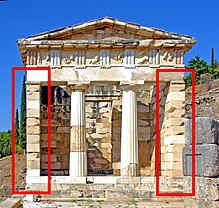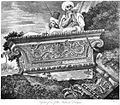Anta (architecture): Difference between revisions
No edit summary |
|||
| Line 1: | Line 1: | ||
| ⚫ | |||
| ⚫ | |||
An '''anta''' (pl. antæ) ([[Latin]], possibly from ''ante'', 'before' or 'in front of') is an [[architecture|architectural]] term describing the [[Column|posts]] or [[column|pillar]]s on either side of a [[door]]way or [[Gate|entrance]] of a [[Greek temple]] - the slightly projecting piers which terminate the walls of the [[cella|naos]].{{sfn|Roth|1993|p={{page needed|date=March 2013}}}} |
An '''anta''' (pl. antæ) ([[Latin]], possibly from ''ante'', 'before' or 'in front of') is an [[architecture|architectural]] term describing the [[Column|posts]] or [[column|pillar]]s on either side of a [[door]]way or [[Gate|entrance]] of a [[Greek temple]] - the slightly projecting piers which terminate the walls of the [[cella|naos]].{{sfn|Roth|1993|p={{page needed|date=March 2013}}}} |
||
==Anta== |
==Anta== |
||
| ⚫ | |||
| ⚫ | |||
In contrast to pillars, they are directly connected with the walls of a temple. They owe their origin to the vertical posts of timber employed in the early, more primitive palaces or temples of Greece, as at [[Tiryns]] and in the [[Temple of Hera (Olympia)|Temple of Hera at Olympia]]. They were used as load-bearing structures to carry the roof timbers, as no reliance could be placed on walls built with unburnt brick or in [[rubble masonry]] with clay mortar. Later, they became more decorative as the materials used for wall construction became sufficient to support the structure.{{sfn|Chisholm|1911|p=88}} |
In contrast to pillars, they are directly connected with the walls of a temple. They owe their origin to the vertical posts of timber employed in the early, more primitive palaces or temples of Greece, as at [[Tiryns]] and in the [[Temple of Hera (Olympia)|Temple of Hera at Olympia]]. They were used as load-bearing structures to carry the roof timbers, as no reliance could be placed on walls built with unburnt brick or in [[rubble masonry]] with clay mortar. Later, they became more decorative as the materials used for wall construction became sufficient to support the structure.{{sfn|Chisholm|1911|p=88}} |
||
Revision as of 06:34, 8 November 2016

An anta (pl. antæ) (Latin, possibly from ante, 'before' or 'in front of') is an architectural term describing the posts or pillars on either side of a doorway or entrance of a Greek temple - the slightly projecting piers which terminate the walls of the naos.[1]
Anta

In contrast to pillars, they are directly connected with the walls of a temple. They owe their origin to the vertical posts of timber employed in the early, more primitive palaces or temples of Greece, as at Tiryns and in the Temple of Hera at Olympia. They were used as load-bearing structures to carry the roof timbers, as no reliance could be placed on walls built with unburnt brick or in rubble masonry with clay mortar. Later, they became more decorative as the materials used for wall construction became sufficient to support the structure.[2]
When there are columns between antae, as in a porch facade, rather than a solid wall, the columns are said to be in antis. (See temple.)[2]
Anta capitals


The top of antae is often highly decorated, usually with bands of floral designs. These form brick-shaped capitals, called "anta capitals".
-
Doric anta capital at the Temple of Hephaistos, Athens, 450 BCE.
-
Ornamentation of the front part of an anta capital at the Erechtheion, 525 BCE.
-
Unadorned Ionic anta capital at the Temple of Athena Nike, Athens, 420BCE.
-
Corinthian anta capital at the Niha Bekaa Roman Temple, 1st century AD.
"Sofa" anta capitals
An anta capital can sometimes be qualified as a "sofa" capital or a "sofa anta capital" when the sides of the capital broaden upward, in a shape reminiscent of a couch or sofa.[3] These capital can also be described as pilaster capitals, which, strictly speaking, are normally decorative rather than structural components.[4]
During the Greek period, anta capitals has designs different from those of colum capital, but during Roman and later times this difference disappeared and both column and anta capitals has the same types of designs.[5][6]
-
Anta capital, Didyma.
-
Anta capital from Miletus (front view).
-
Anta capital at the Temple of Apollo in Didyma, front and profile. 4th century BCE.
-
The Pataliputra capital, a Hellenistic anta capital from India (3rd century BCE).
Distyle in antis
Early Greek temples such as the 6th century Siphnian Treasury had antae on both side of the porch, framing a set of columns (a disposition named "distyle in antis", meaning "two columns in between antae"). This was an early type of temple construction (the "distyle temple") meant to reinforce weak wall construction by head posts, the antae. Sometimes, the walls were in brick, and thus needed this kind of reinforcement, as in the Heraeum of Olympia (c. 600 BCE).[7]
-
Early Greek temples such as the Siphnian Treasury had antae on both side of the porch, framing a set of columns.
-
Front view of the Siphnian Treasury with framing antae.
-
The Athenian Treasury in Delphi is also a distyle in antis design.
Notes
- ^ Roth 1993, p. [page needed].
- ^ a b Chisholm 1911, p. 88.
- ^ Architectural Elements, Emory University
- ^ "The New and Improved Practical Builder: Masonery, bricklaying, plastering" Peter Nicholson, Thomas Kelly, 1837, p.68 [1]
- ^ A handbook of ornament, by Franz-Sales Meyer [2]
- ^ The Classical Language of Architecture by John Summerson, p.47 "Anta" entry [3]
- ^ Encyclopedia Britannica, Anta entry [4]
References
- Roth, Leland M. (1993). Understanding Architecture: Its Elements, History and Meaning (First ed.). Boulder, CO: Westview Press. ISBN 0-06-430158-3.
{{cite book}}: Invalid|ref=harv(help)
- Attribution
This article incorporates text from a publication now in the public domain: Chisholm, Hugh, ed. (1911). "Antae". Encyclopædia Britannica. Vol. 1 (11th ed.). Cambridge University Press. p. 88.











